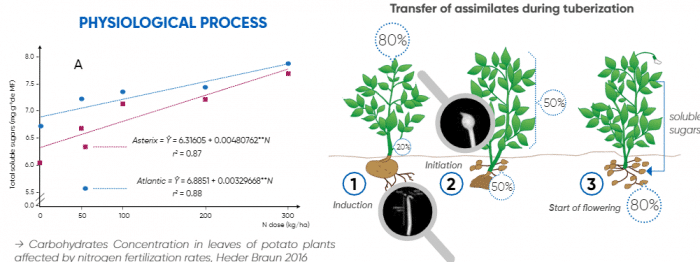How to Increase Potato Tuber Size and Yield

The main challenge for farmers at the end of the tuber initiation phase is to achieve a high number of tubers above 15 mm. Any tubers that do not reach this size shrink and disappear. The main challenge after the tuber initiation phase is to optimise the reserves and obtain a maximum of marketable tubers.
Potatoes are a demanding and lethargic crop. Their P requirements during the tuber initiation phase are high. To achieve an optimal yield, 50% of the phosphorus requirement must be absorbed between 15 and 45 days after emergence. Potatoes are also a crop with a shallow root system. Therefore, phosphorus needs to be close to the roots and also the soil’s P content needs to be high enough. Once the number of tubers is established, the quality of the filling will impact the yield. During this tuber filling phase, N and K in turn become essential.
Photosynthesis is the biochemical pathway that converts light energy into glucose molecules. This phase requires high nitrogen levels – nitrogen being a component of chlorophyll, the pigment where photosynthesis occurs. Following glucose production, the molecules bind to form starch, which is a chain of glucose. During initiation, assimilates and soluble sugars (products of photosynthesis) begin to be distributed in the young tubers through the phloem. This transfer of nutrients requires a lot of energy and potassium, which is essential for nutrient transport. At the end of the tuber initiation phase, there is no more leaf formation or growth, and the assimilates are mainly found in the tubers. At the end of the cycle (senescence), the complete transfer of assimilates and water from the leaves and stems to the tubers occurs.
To find out which TIMAC AGRO technologies are recommended to improve the tuber size and marketable yield of potatoes, contact us!

